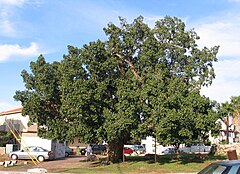Ficus sycomorus
| Ficus sycomorus subsp. var. | Sycamore Fig, Fig-mulberry | |||||||||||||||||||||||||||||||||||||||||||||||||||||||
|---|---|---|---|---|---|---|---|---|---|---|---|---|---|---|---|---|---|---|---|---|---|---|---|---|---|---|---|---|---|---|---|---|---|---|---|---|---|---|---|---|---|---|---|---|---|---|---|---|---|---|---|---|---|---|---|---|

|
|
| ||||||||||||||||||||||||||||||||||||||||||||||||||||||
| ||||||||||||||||||||||||||||||||||||||||||||||||||||||||
Ficus sycomorus, called the sycamore fig or the fig-mulberry (due to the leaves' resemblance to those of the Mulberry), sycamore, or sycomore, is a fig species that has been cultivated since early times. (Note that the name sycamore has been used for a variety of plants.) In its native habitat, the tree is usually found in rich soils along rivers, but also in mixed woodlands.
Ficus sycomorus grows to 20 m tall and 6 m wide with a dense round crown of spreading branches. The leaves are heart-shaped with a round apex, 14 cm long by 10 cm wide, and arranged spirally around the twig. They are dark green above and lighter with prominent yellow veins below, and both surfaces are rough to the touch. The petiole is 0.5–3 cm long and pubescent. The fruit is a large edible fig, 2–3 cm in diameter, ripening from buff-green to yellow or red. They are borne in thick clusters on long branchlets or the leaf axil. Flowering and fruiting occurs year-round, peaking from July to December. The bark is green-yellow to orange and exfoliates in papery strips to reveal the yellow inner bark. Like all other figs, it contains a latex.
Cultivation
Propagation
Pests and diseases
Varieties
- Ficus sycomorus ssp. sycomorus
- Ficus sycomorus ssp. gnaphalocarpa (Miq.) C.C. Berg
Gallery
References
External links
- w:Ficus sycomorus. Some of the material on this page may be from Wikipedia, under the Creative Commons license.
- Ficus sycomorus QR Code (Size 50, 100, 200, 500)
